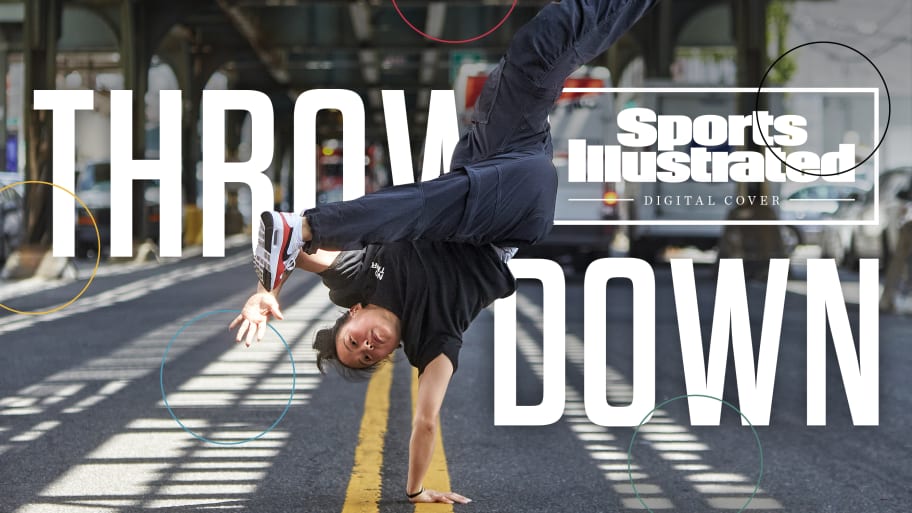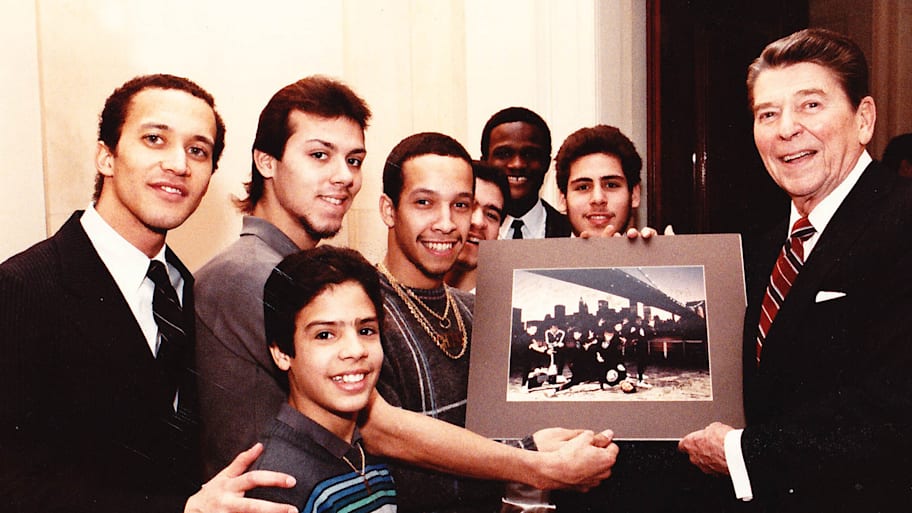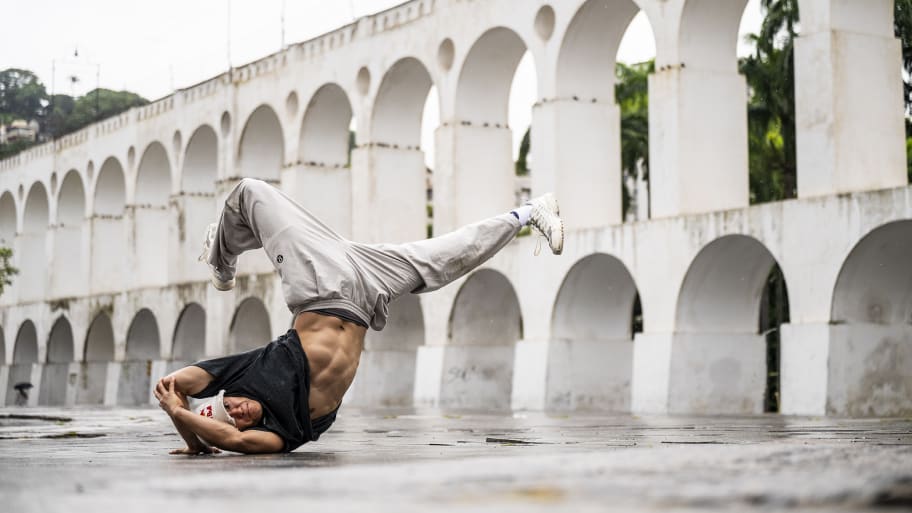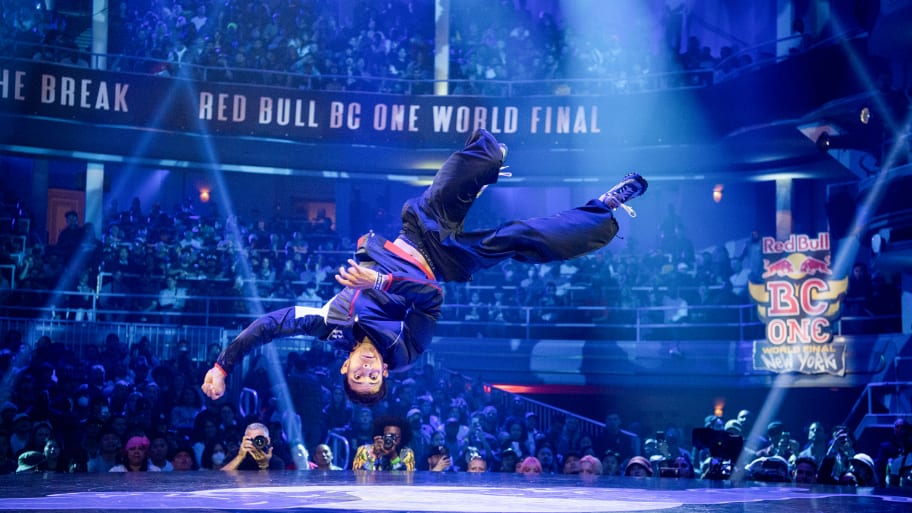
Unless you lived through it—ideally while wearing parachute pants—you might have a hard time fully grasping just how omnipresent breaking was in 1980s pop culture. There were movies based on it, like Beat Street, Breakin’ and its successor, Breakin’ 2: Electric Boogaloo, whose subtitle has lived on for decades as a punch line for pretty much every sequel made. There were obligatory breaking scenes in movies—Cocoon, Revenge of the Nerds and countless others—that otherwise had nothing to do with breaking. The sitcom Alice had a breaking episode. Merv Griffin had a crew on his show. Barney Rubble showed off his moves in a commercial for Cocoa Pebbles. It was everywhere.
Naturally, politicians saw a popular trend and were eager to get in on the action. So it was that at his second inauguration gala, in January 1985, a tuxedoed Ronald Reagan watched as Jimmy Stewart introduced the New York City Breakers, prompting a nation of viewers to ask themselves, How the hell did we get here? The answer only makes the story stranger (and whiter and older): It was Frank Sinatra’s idea. “Frank was a hoofer,” says Michael Holman, who founded and managed the group. “He came from a tradition where you had to sing and dance. You couldn’t just be a singer. He loved us.”

Ol’ Blue Eyes had first encountered the Breakers in late 1983 at the Kennedy Center Honors, where they performed as part of a tribute to the dancer Katherine Dunham. When it came time to book acts for Reagan’s party, Sinatra, who was organizing the event, reached out to Holman. A San Francisco native, Holman had moved to New York City in ’78 to take a job as a banker. He hated the job but loved the city, where he was becoming a fixture in the downtown art scene while also immersing himself in the nascent world of hip-hop. He started an experimental noise band with artist Jean-Michel Basquiat. He took Malcolm McLaren—the British impresario who created the Sex Pistols—up to the Bronx to meet Afrika Bambaataa. While running a weekly hip-hop night at an East Village reggae club called Negril, Holman saw the crowd go wild over a breaking battle between two crews, the Floor Masters and the Rock Steady Crew, which gave him the inspiration to form the New York City Breakers.
In less than a year they were booking gigs all over the place. Among the many TV spots that featured Holman’s crew was one that aired in 1984. In it, one of the Breakers, a B-Boy named Chino Lopez (better known as Action), threw down a gauntlet: “Me and my whole crew, we challenge the 1984 [Olympic] gold medal winners in the floor exercise gymnastics team in a competition. We’ll see you in L.A.”
Lamentably, the world never got to see that showdown, and by the middle of ’85 the mainstream breaking scene had dried up almost as quickly as it had sprung up. But 40 years later, Action’s wish has come true. Breaking (it’s breaking, not breakdancing, by the way) is making its Games debut in Paris, but not without questions from those within the community. Like, does something that started as an art form, born on the streets of the Bronx in the 1970s in a neighborhood that was largely disenfranchised, belong at something as corporate as the Olympics?
Sunny Choi had Olympic dreams as a kid growing up in Louisville, but she saw herself as a gymnast, not a dancer. By the time she enrolled at Penn she was burned out on the sport. Without it, though, she was lacking direction. One night on the way home from a party she came across a group of breakers on campus. They had a club and convinced her to come to a free class a few days later, and she quickly got hooked.
“The reason I fell in love with it was because it was so different from gymnastics,” Choi says. “My whole life I had been living by this very, very organized list of checked boxes. What I loved about breaking is that it challenged that. It requires you to show up and to figure out who you are and express yourself.” And no matter how she expressed herself, she was accepted. In that world, she says, “You blend in by not fitting in.”
Choi, 35, graduated from college in 2011. She got into marketing, eventually making her way up to global creative operations director for Estée Lauder. She kept breaking, working out whenever she could find the time in her busy schedule. For 10 years she deftly moved between two worlds, one corporate, one hip-hop. After the IOC announced in 2020 that breaking would be added to the program in Paris, Choi used it as motivation to go all in. She quit her job, becoming B-Girl Sunny full-time.
Soon Choi was ranked in the world’s top 10. She clinched her spot in the Olympics when she won gold at the 2023 Pan Am Games. (A country can send up to two B-Girls and two B-Boys; the other U.S. competitor who directly qualified is Victor Montalvo.)

Like Choi, Canada’s B-Boy Philip Kim, who also earned a ’23 Pan Am Games gold medal, stumbled into the sport by chancing upon some breakers. In Kim’s case, it was outside an art museum in his hometown of Vancouver. Replicating the crew’s moves gave the middle schooler an outlet for his ample energy.
“I was super into anime and so were a lot of my friends,” he says. “So we would make up characters and play at recess. And I did the same at home. My parents remember me running around in my underwear at home, pretending to be Goku or Spider-Man.”
By the time he was in ninth grade, his classmates had dubbed him B-Boy Kimchi. (He’s since adopted a new moniker: Phil Wizard, the surname coming from a crew he used to be a part of.) Becoming a professional was a no-brainer, and not just because he’s good (he was the 2022 world champion). His career allows him to connect with those superhero days. “For me, now, breaking is reminiscent of that in a way, because I just kind of travel the world, doing dance battles,” he says.
Breaking has always had a competitive element. “If you were poor, you got your best clothes on and your best cologne, you’re styling,” says Michael Chambers, a B-Boy known as Boogaloo Shrimp and one of the stars of 1984’s Breakin’ and its sequel. “If you’re styling and you ain’t got much money and you took a bus to the club, you could still be the king of the city if you had the right talent. The battling thing was like, O.K., I’m going to bruise your ego. I may be broke, but I’m no joke. Watch this. Boom!” (It bears noting that Chambers, who last year put out a kids book called Lil’ Boogaloo Shrimp and the Clean Sweep, would like to be the Charles Barkley of breaking.)
When Chambers and fellow breaker Adolfo Quiñones threw down against the Electro Rock on film (with a young Ice-T as the DJ), the people in the room decided who won, crowning the winner by acclamation. The sport of Olympic breaking is a wholly different animal.
The competitors face off head-to-head, alternating turns in a series of three throw downs, each of which can last up to a minute. A panel of judges declares the winner. There are no required moves and while it is literally dancing, it’s rarely choreographed. “I only plan about 20 to 30% of a round,” says Choi. “But even then, sometimes that goes out the window and I’ll change it right on the spot.”
Montalvo, 30, who competes as B-Boy Victor, will plan out three signature moves in each throw down. “I try to keep myself 50% structured and then 50% improvised,” he says.

Part of that improvisation is going with the flow, but there’s also a strategic element at play. “Often times I’m responding to the opponent,” says Kim. “In breaking we often talk about having a conversation with movement. If someone does a move but I have a better variation of it, it’s also showing the judges, Look, he’s adapting in the moment. He’s also showing that he’s listening to the opponent.”
Kim has an especially deep repertoire of moves—a vocabulary, in the sport’s parlance—which makes him tough to beat, since judges are on the lookout for a variety of techniques, including:
- Top rock, which are steps done while on one’s feet.
- Down rock, or moves on the floor with the hands mostly supporting the breaker.
- Power moves, such as head spins and windmills.
- Freezes, which are exactly what they sound like.
“You’re using every muscle in your body, basically, in a way that you don’t in your everyday life,” says Choi. “You’re not just walking on your feet. You’re upside down, you’re rotating, you’re spinning, you’re sliding.”
That means that in addition to dance work, there’s a lot of time spent in the gym. “It’s usually a combination of strength training, explosive work, high intensity interval training—things that will help my breaking as well as exercises that will work the antagonist muscles,” says Kim. “Breaking is a lot of push movements. So I will incorporate a lot of pull movements into my workouts so that I’m not imbalanced with my body.”
While the goal of a breaker is to exert total control over their body, there’s one thing they have zero control of: the music. Unlike gymnasts or figure skaters, who arrive with predetermined music, B-Boys and B-Girls are at the mercy of the DJ, who picks the tunes. The only thing competitors know ahead of time is a rough range of beats per minute.
Not only does the music selection make preparation tricky, it’s also a source of controversy. In Paris, because of copyright laws, you won’t hear any old-school hip-hop, which feeds into the main argument by critics of breaking’s inclusion in the Olympics: that not enough is done to connect the sport to its roots, especially when it will draw millions of eyeballs.
Gabriel Dionisio, better known as Kwikstep, grew up breaking in New York City in the 1980s. He finds himself frustrated by way the sport is being presented. “I’m excited by [the Olympics] and its potential of exposing breaking further to the world,” he says. “What I’m concerned with is the lack of cultural representation. Its origins, where it comes from.”
With his wife, Ana Garcia (the groundbreaking B-Girl Rokafella), Dionisio runs a non-profit, Full Circle Productions, that procures grant money from the likes of the Ford Foundation and the Mellon Foundation. They use the funds to help put on shows and to educate young people about the roots of breaking. Ahead of an event Dionisio will make sure the MC knows the stories of any old school B-Boys who are there, and he sets up a booth where crews can put up old photos. “Now it has a social context,” he says.
Ken Gabbert is a little more blunt. As Ken Swift, he was a pioneering member of the Rock Steady Crew. “It’s not a sport,” he says. “An art form that we created with our own terminology and heritage and tradition, all of a sudden for an opportunity, we start calling ourselves athletes and calling this art a sport? That’s like saying, ‘Let’s call basketball a dance now after 75 years.’ As a part of a culture, I look at it from a different perspective. I look at it artistically, as something that we’ve sustained for 50 years to get to this point.
“I love sports. I get that. But when I was breaking, the whole aspect of doing stuff with my body—the type of freedom, really connecting to drums and music—was different for me. So right now I see what’s happening. A lot of people act like I’m a hater, but they’re wrong. It’s just that I have a culture I’m a part of called hip-hop, and it ain’t going to change.”

Holman—who speaks passionately about the community-building and storytelling power of breaking—sees both sides of the argument. Ultimately he’s in favor of the Olympics (he petitioned to have breaking included in 1984), but he does have concerns about where the sport is headed. “A lot of these new jack, young breakers, many of them are these incredible gymnasts,” he says. “It’s not just gymnastics, it’s also gyroscopic control over your own body. And they’re doing these moves that are just out of this world. But are they dancing to the music?
“You see them going into their routine and they’re on beat, but then they’re going into these moves that are living in their own time and space and have nothing to do with the beats and the rhythm and the melody and the energy and the emotional power of the song and of the music. They’re just doing these moves and challenging someone else to do a move as powerful. You don’t even need music to do it. If your routine can just be done without music, then that’s not breaking.”
Most young breakers are attuned to the discussion. Montalvo, whose father and uncle were B-Boys in Mexico, says he doesn’t really like dancing to the music at competitions: “ ‘Apache’ [by the Incredible Bongo Band] or James Brown’s ‘Break It Loose’ remix? You put those on and that’ll have us dancing all night.”
Choi, who aspires to open a dance and community center in Queens, says one thing she doesn’t like in her role as B-Girl Sunny is doing press. But, she says, “I do it a lot to share about breaking and the community, about the culture. You don’t have breaking without hip-hop. You don’t have breaking without the culture.”
It’s a point echoed by Kim, but being a 27-year-old Canadian means he doesn’t have the personal experience of the old school, which in turn means he’ll more readily accept an evolution. “It comes from Black and Latino culture,” he says. “That’s the roots of where it came from. But I think it also speaks on the beauty of where breaking and hip-hop in general can go.”
One place breaking, ironically, won’t go is back to the Olympics. It’s not on the docket for the 2028 Games, a head-scratching decision by the IOC given that they’re to be held in Los Angeles, one of the hotbeds of the early days of the art form. Keeping it on the program would give the sport a chance to grow its popularity further and maybe a second appearance, one without the novelty that comes with a debut, would mean more time could be spent on discussing the history. And breaking has always had a way of delivering memorable sequels.
This article was originally published on www.si.com as Breaking Will Make Its Olympic Debut in Paris, but Not Without Controversy .







